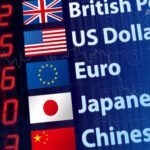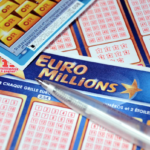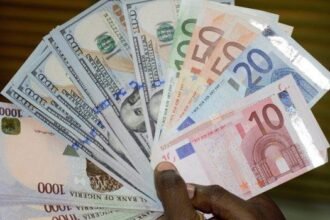EUR/USD lost about 1% in the previous week but managed to stabilize above 1.1500 in the European morning on Monday. The pair’s near-term technical outlook shows that the bearish bias remains intact but struggles to gather momentum.
Euro Price Last 7 Days
The table below shows the percentage change of Euro (EUR) against listed major currencies last 7 days. Euro was the weakest against the US Dollar.
| USD | EUR | GBP | JPY | CAD | AUD | NZD | CHF | |
|---|---|---|---|---|---|---|---|---|
| USD | 0.93% | 0.52% | 1.44% | 0.56% | 1.16% | 1.33% | 1.91% | |
| EUR | -0.93% | -0.30% | 0.88% | -0.35% | 0.21% | 0.41% | 0.99% | |
| GBP | -0.52% | 0.30% | 0.92% | -0.05% | 0.51% | 0.71% | 1.29% | |
| JPY | -1.44% | -0.88% | -0.92% | -0.85% | -0.27% | -0.11% | 0.44% | |
| CAD | -0.56% | 0.35% | 0.05% | 0.85% | 0.59% | 0.76% | 1.35% | |
| AUD | -1.16% | -0.21% | -0.51% | 0.27% | -0.59% | 0.20% | 0.78% | |
| NZD | -1.33% | -0.41% | -0.71% | 0.11% | -0.76% | -0.20% | 0.58% | |
| CHF | -1.91% | -0.99% | -1.29% | -0.44% | -1.35% | -0.78% | -0.58% |
The heat map shows percentage changes of major currencies against each other. The base currency is picked from the left column, while the quote currency is picked from the top row. For example, if you pick the Euro from the left column and move along the horizontal line to the US Dollar, the percentage change displayed in the box will represent EUR (base)/USD (quote).
Ahead of the weekend, the US Dollar (USD) lost some strength as dovish comments from Federal Reserve (Fed) policymakers revived expectations of a 25 basis points (bps) rate cut in December.
Fed Governor Stephen Miran, who preferred a 50 bps rate cut in the previous two policy meetings, noted that he would vote for a 25 bps rate cut in December, if his vote were to be the deciding factor whether the Fed would lower the policy rate. Moreover, NY Fed President John Williams hinted that he could vote for a rate cut at the next meeting, saying “I view monetary policy as being modestly restrictive. Therefore, I still see room for a further adjustment in the near term.”
According to the CME FedWatch Tool, markets are currently pricing in about a 70% probability of a 25 bps rate cut at the next meeting, compared to about 50% early Friday.
The economic calendar will not feature any high-tier data releases from the US on Monday. Meanwhile, US stock index futures were last ween rising between 0.25% and 0.7%. If Wall Street makes a bullish opening and the risk rally gathers steam in the second half of the day, the USD could come under renewed selling pressure and help EUR/USD edge higher.
EUR/USD Technical Analysis:
The 20-period Simple Moving Average (SMA) declines beneath the 50-, 100-, and 200-period SMAs, underscoring a bearish bias. The longer SMAs also slope lower and the pair holds below all of them, keeping sellers in control. The Relative Strength Index (RSI) at 41.7 sits below the midline, showing weak momentum, while the modest pickup hints at stabilizing pressure rather than a trend shift.
Measured from the 1.1885 high to the 1.1476 low, the 23.6% retracement at 1.1572 acts as resistance, with the 38.2% retracement at 1.1632 overhead. On the downside, first support is seen at 1.1451 (static level), then at 1.1400 (static level). A sustained break above nearby barriers could improve the tone, while failure to reclaim them would preserve the downside bias.
(The technical analysis of this story was written with the help of an AI tool)
Euro FAQs
The Euro is the currency for the 20 European Union countries that belong to the Eurozone. It is the second most heavily traded currency in the world behind the US Dollar. In 2022, it accounted for 31% of all foreign exchange transactions, with an average daily turnover of over $2.2 trillion a day.
EUR/USD is the most heavily traded currency pair in the world, accounting for an estimated 30% off all transactions, followed by EUR/JPY (4%), EUR/GBP (3%) and EUR/AUD (2%).
The European Central Bank (ECB) in Frankfurt, Germany, is the reserve bank for the Eurozone. The ECB sets interest rates and manages monetary policy.
The ECB’s primary mandate is to maintain price stability, which means either controlling inflation or stimulating growth. Its primary tool is the raising or lowering of interest rates. Relatively high interest rates – or the expectation of higher rates – will usually benefit the Euro and vice versa.
The ECB Governing Council makes monetary policy decisions at meetings held eight times a year. Decisions are made by heads of the Eurozone national banks and six permanent members, including the President of the ECB, Christine Lagarde.
Eurozone inflation data, measured by the Harmonized Index of Consumer Prices (HICP), is an important econometric for the Euro. If inflation rises more than expected, especially if above the ECB’s 2% target, it obliges the ECB to raise interest rates to bring it back under control.
Relatively high interest rates compared to its counterparts will usually benefit the Euro, as it makes the region more attractive as a place for global investors to park their money.
Data releases gauge the health of the economy and can impact on the Euro. Indicators such as GDP, Manufacturing and Services PMIs, employment, and consumer sentiment surveys can all influence the direction of the single currency.
A strong economy is good for the Euro. Not only does it attract more foreign investment but it may encourage the ECB to put up interest rates, which will directly strengthen the Euro. Otherwise, if economic data is weak, the Euro is likely to fall.
Economic data for the four largest economies in the euro area (Germany, France, Italy and Spain) are especially significant, as they account for 75% of the Eurozone’s economy.
Another significant data release for the Euro is the Trade Balance. This indicator measures the difference between what a country earns from its exports and what it spends on imports over a given period.
If a country produces highly sought after exports then its currency will gain in value purely from the extra demand created from foreign buyers seeking to purchase these goods. Therefore, a positive net Trade Balance strengthens a currency and vice versa for a negative balance.





















